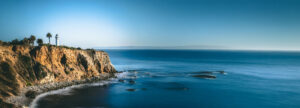The story of Jan and Rich — Part 1
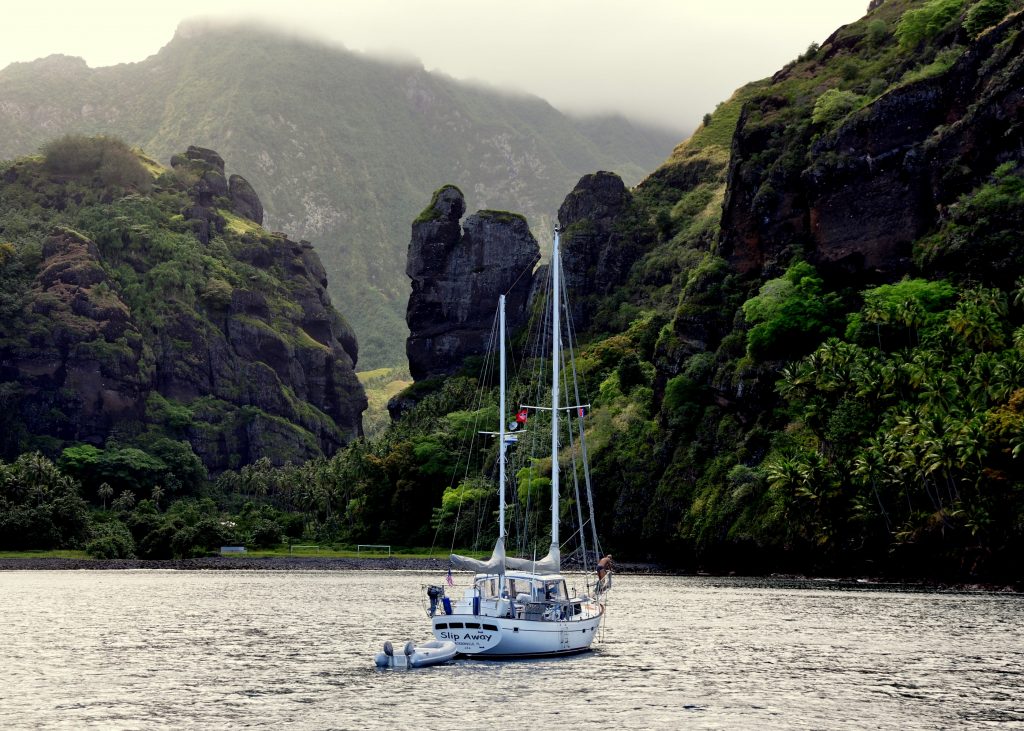
Travel is fatal to prejudice, bigotry and narrow-mindedness — Mark Twain
In 2001, Jan Schwab and Rich Crowell bought a sailboat in Mexico and named her Slip Away. They brought Slip Away to Los Angeles in 2002 and lived on her for a year in Marina del Rey. Then in 2003, at the ages of 45 and 54 respectively, Jan and Rich sailed to Ensenada, Mexico, and started a 16-year journey that would take them around the world.
From 2003 to 2019, Jan and Rich sailed a total of 57,000 nautical miles on Slip Away, visiting 33 countries during their circumnavigation of the globe. They are my clients*, and I thought it would be fun to share their story with you.
Adam Hartrum: Why did you want to sail around the world?
Jan Schwab: We were planning a sailing vacation with another couple, and I started looking at some websites of people who lived on their sailboats in the Caribbean and ran charters on them. We both loved the Caribbean islands and the scuba-diving there. We liked living in L.A., but neither of us were averse to change. I said to Rich, “What do you think about selling all of our stuff, buying a boat and running charters in the Caribbean?”
Rich Crowell: Jan’s question totally caught me off guard, but the idea appealed to me, so I started doing research. I subscribed to the Seven Seas Cruising Association’s monthly bulletin — stories of people cruising in all parts of the world, windows into a new and different lifestyle. We were intrigued about “cruising,” but most of these people were not working, and we questioned whether we could afford to do it. We were living a comfortable life in Los Angeles, but we weren’t rolling in money. Also, if we were going to run charters, we would need more sailing experience, so we decided to give the cruising life a try.
Jan: Once we moved onto the boat and left L.A., we found that we could live on a lot less money, and the chartering idea went out the window. We joined this whole community of people sailing, living frugally and seeing the world.
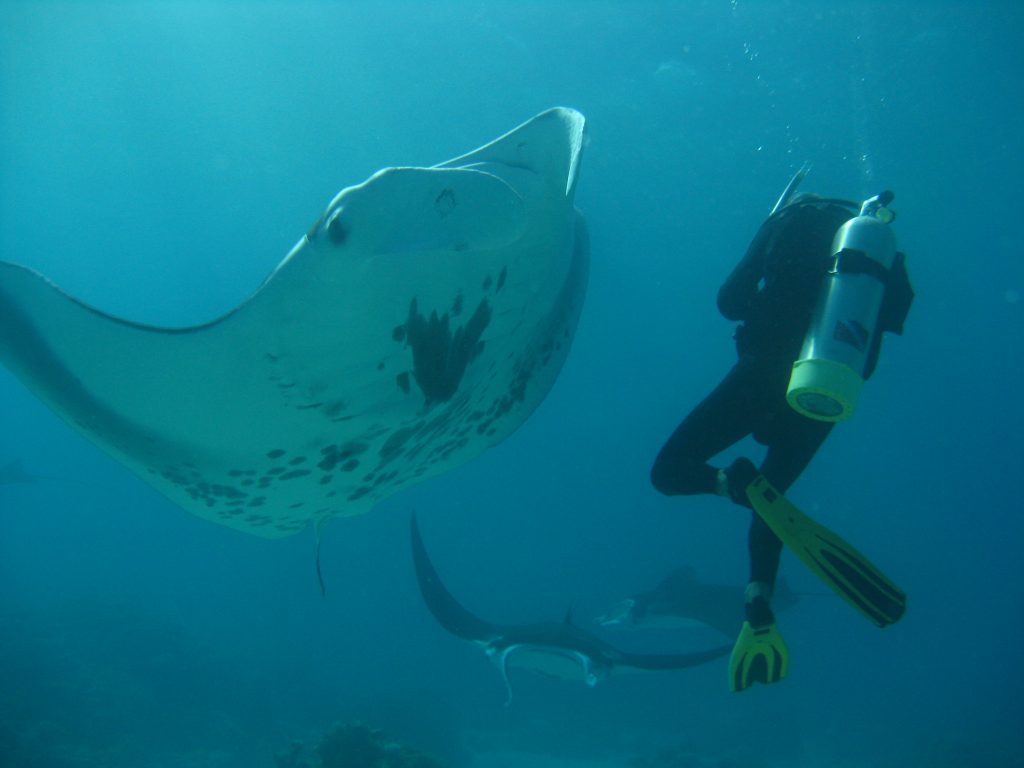
Adam: What is one of your favorite places?
Jan: Fatu-Hiva, which is an island in the Marquesas in the South Pacific. We had been at sea for 21 days and it was the first time we had ever done a long passage like that. We pulled into this anchorage that was just stunning. It was breathtaking. We were feeling this elation of having completed our passage safely to this beautiful place.
Rich: It’s the longest passage anywhere around the world that you don’t have an option to stop — 3,000 miles — between the Galapagos and the Marquesas.
Fatu-Hiva is a tall, rugged volcanic island. It’s completely carpeted in green — the most lush, wonderful place. There are flowers everywhere, and the smell of the soil and flowers wafted into the anchorage.
Jan: It’s not a tourist destination, and the local people were very welcoming. There were several other boats with which we had been sailing across the ocean, and we had kept in touch with them on the ship’s radio. We pulled into the anchorage, and another boat pulled in maybe a couple hours after us. Then another boat came in the next day. The sailors we had met either on the radio or in the Galapagos were all arriving.
It was such a feeling of joy. The scenery was spectacular. We went hiking to a waterfall and swam in the pool under the waterfall. It was almost like a dream – we had to pinch ourselves to make sure it was real.
It’s the most lush, wonderful place. There are flowers everywhere, and the smell of flowers wafted into the anchorage.
Adam: What were conditions like sailing from the Galapagos to the Marquesas?
Rich: We had very good winds, but it was not comfortable and placid. The seas were a little robust, but nothing threatening. Three or four days after leaving the Galapagos, we hit the trade winds, set our sails and amazingly we didn’t change our sails for nearly 17 days.
Jan: The passage across the Pacific is referred to as the “Coconut Milk Run.” But, people who have done it often call it the “Coconut Milk Shake.” Once we got into the trade winds, Rich commented about the rough seas. I just looked at him and said, “We have 17 more days of this, so we need to suck it up!” After a few days, we got accustomed to the constant motion of the boat.
Adam: Please share another adventure.
Jan: We were at a place called Suwarrow, an uninhabited atoll about 700 miles west of Bora Bora in the South Pacific. We went scuba diving, had just gotten in the water, and four or five manta rays came and played with us.
Rich: They would swoop up over you, each with a wingspan of probably 10 to 12 feet. They did this for about 15 minutes, and then we swam off to see more of the coral reef. When we came back to our dinghy at the end of our dive, two of them were waiting under it. They wanted to play some more!
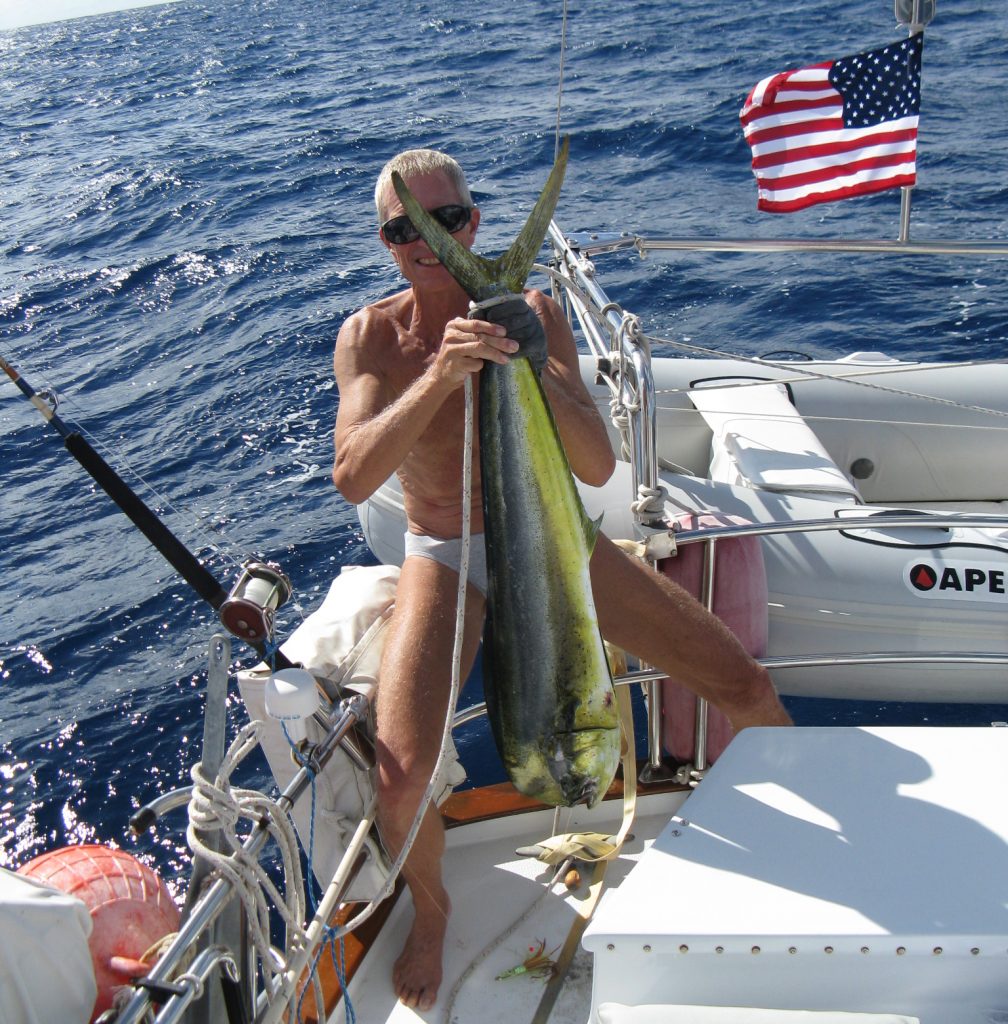
Adam: What did you eat during passages?
Jan: We stocked up on provisions in places that had good shopping options — Panama, New Zealand, Australia, Malaysia, South Africa. We had a refrigerator and a freezer on the boat, space under the floor to store canned goods and other stowage areas for dry goods.
Before we left on longer passages, I prepared and froze some meals — chili, pasta, risotto — one-pot meals that could easily be heated up on the stove. We also had sandwiches and wraps, cereals, and peanut butter was a staple.
Rich: Our diet didn’t change that much. We could usually find great fresh fruits and veggies in local markets. We adapted to things that were locally available, and we tried new foods. For example, we had a lot of pamplemousse in French Polynesia. It’s grapefruit, but it’s completely different than anywhere else. It’s not tart. It’s sweet and delicious.
Jan: Sometimes we would catch a fish such as a large mahi-mahi, wahoo or Spanish mackerel that would give us eight or 10 meals.
Rich: We caught a big mahi-mahi on our way to Key West, and when we went into the grocery store there, we looked at the price of it saying, “Oh, my God. We’re eating a fortune.”
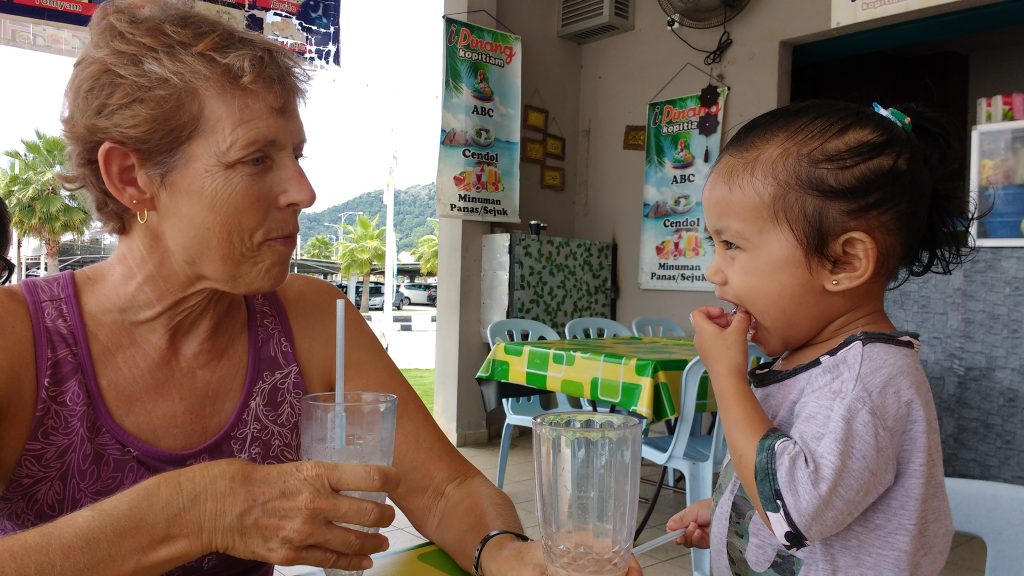
Adam: Tell us about the boat.
Rich: It was a 1978, 41-foot, Islander Freeport. Islander was the manufacturer, Freeport the model. It was a ketch-rig full keel boat — a heavy, strong boat.
Jan: Not a fast boat, but pretty comfortable.
Adam: Who did the piloting?
Rich: We both did.
Jan: When we were on a multi-day passage, we settled on a six-hour watch schedule. One of us was awake and on watch for six hours, and the other one could relax, sleep, read, do whatever they wanted. Then, after those six hours, we would switch.
We had an autopilot that steered the boat, because trying to steer that distance with just two people would be totally exhausting. Our autopilot was the most reliable piece of gear we had on the boat.
Rich: Everything else broke at least once and had to be repaired.
Rich commented about the rough seas. I just looked at him and said, “We have 17 more days of this, so we need to suck it up!”
Adam: How fast is the learning curve to become a competent sailor?
Jan: It’s not only learning how to sail the boat, but also all the systems that were on the boat — the electronics, battery bank management, water maker, refrigeration, engine and generator. The first year of cruising is often described as “drinking from a firehose.”
Rich: You have to be your own plumber, your own electrician, your own mechanic. There’s often no one to help you. We were conscientious about trying to make sure we both knew the basics of each other’s jobs in case something happened. Jan ended up doing most of the navigation and voyage planning. I was usually busy fixing stuff.
Jan: We both learned how to handle the boat. We had smaller boats before, so we knew the basics of sailing, but Slip Away was a lot bigger and heavier and not as responsive as our smaller sailboats. Also, as I mentioned, the systems on this boat were more complicated. For, example, we had a whole new electronics system installed before we left L.A., and we had to study the manuals to learn how to use it. Neither of us had ever used radar before, but we figured it out.
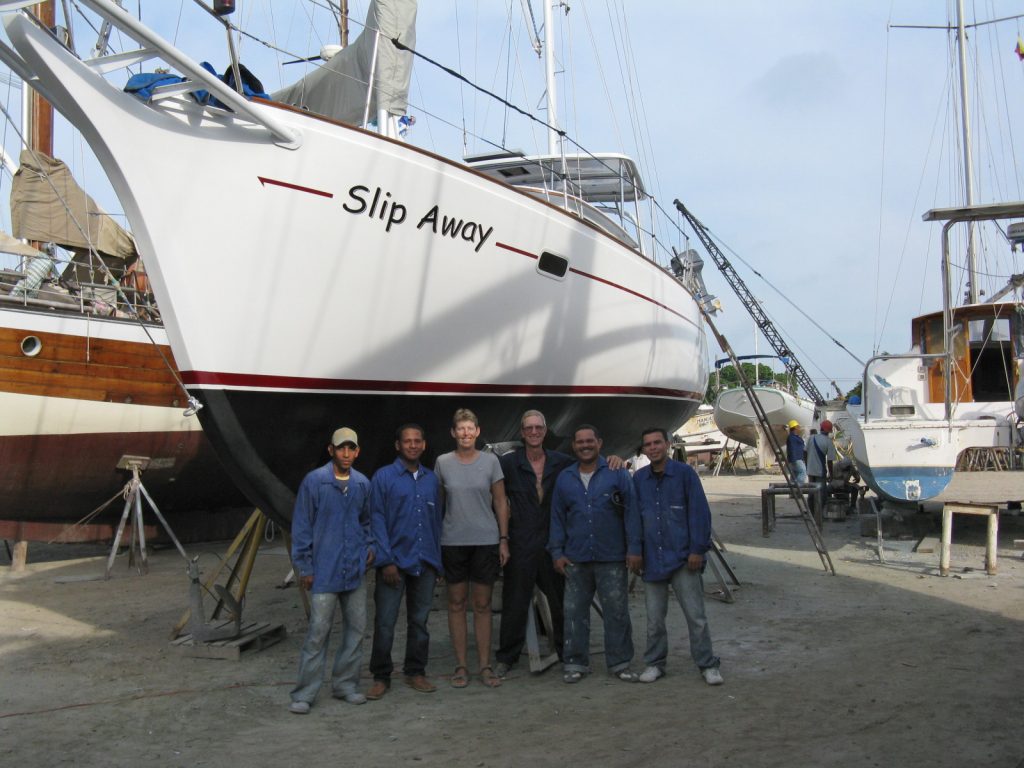
Adam: What is your favorite part of the sailing lifestyle?
Jan: Living in other countries for extended periods of time, which provided opportunities for more and different interactions with the local people. In Malaysia, we had our favorite Indian restaurant, and the people there knew us when we came in. We also had the boat in a boatyard there, and the people who worked in the office and yard were super nice and gracious. They bent over backwards to help us.
Rich: I ended up tearing my rotator cuff in Indonesia, and I had it repaired in Singapore. I had about three months of physical therapy with a therapist named Chye Tuan. He was a native-born Singaporean and spoke English perfectly. We got to spend hours talking about all kinds of details about Singapore and its culture during my PT sessions.
Jan: We spent 14 months in Ensenada, Mexico doing a lot of refit work on the boat shortly after we bought it. The locals there were just so nice to us. They would see me in the grocery store, and they would come up and try and practice their English with me. One day, we were walking down the street, and somebody was honking their horn and waving. It was the lady from the pharmacy.
We experienced that, and different degrees of it, all around the world. People were generally very nice and welcoming to us. That was so heartwarming.
Rich: One of the things that we learned in doing this is the dramatic difference between living in a country versus traveling to a country for vacation. We had to buy groceries. We had to buy diesel for the boat. We had to hire local workers and buy boat supplies. We took public transportation. We lived like locals and interacted with the local population in a way that you don’t if you’re just a tourist. And that was special to us. We discovered that the longer you are somewhere, the more layers you delve into. You see details of the way people live that you can’t see any way other than being there for a while.
Learn more about Jan and Rich’s journey on their website slipaway.net.
* The clients featured in this post voluntarily participated in sharing their story. They were chosen at random and not based on previous client experience or performance-based criteria. It is not known whether the clients appearing here approve of LPL Financial or the advisory services provided.

